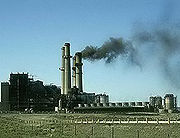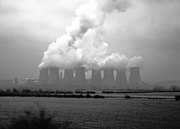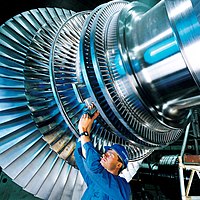Power station
From Wikipedia, the free encyclopedia

A power station (also referred to as generating station or power plant) is an industrial facility for the generation of electric power.[1][2][3]
Power plant is also used to refer to the engine in ships, aircraft and other large vehicles. Some prefer to use the term energy center because it more accurately describes what the plants do, which is the conversion of other forms of energy, like chemical energy, gravitational potential energy or heat energy into electrical energy. However, power plant is the most common term in the U.S., while elsewhere power station and power plant are both widely used, power station prevailing in many Commonwealth countries and especially in the United Kingdom.
At the center of nearly all power stations is a generator, a rotating machine that converts mechanical energy into electrical energy by creating relative motion between a magnetic field and a conductor. The energy source harnessed to turn the generator varies widely. It depends chiefly on what fuels are easily available and the types of technology that the power company has access to.
Contents[hide] |
[edit] Thermal power stations
In thermal power stations, mechanical power is produced by a heat engine, which transforms thermal energy, often from combustion of a fuel, into rotational energy. Most thermal power stations produce steam, and these are sometimes called steam power stations. About 80% of all electric power is generated by use of steam turbines.[citation needed] Not all thermal energy can be transformed to mechanical power, according to the second law of thermodynamics. Therefore, there is always heat lost to the environment. If this loss is employed as useful heat, for industrial processes or district heating, the power plant is referred to as a cogeneration power plant or CHP (combined heat-and-power) plant. In countries where district heating is common, there are dedicated heat plants called heat-only boiler stations. An important class of power stations in the Middle East uses byproduct heat for desalination of water.
[edit] Classification

Thermal power plants are classified by the type of fuel and the type of prime mover installed.
[edit] By fuel
- Nuclear power plants[4] use a nuclear reactor's heat to operate a steam turbine generator.
- Fossil fuelled power plants may also use a steam turbine generator or in the case of natural gas fired plants may use a combustion turbine.
- Geothermal power plants use steam extracted from hot underground rocks.
- Renewable energy plants may be fuelled by waste from sugar cane, municipal solid waste, landfill methane, or other forms of biomass.
- In integrated steel mills, blast furnace exhaust gas is a low-cost, although low-energy-density, fuel.
- Waste heat from industrial processes is occasionally concentrated enough to use for power generation, usually in a steam boiler and turbine.
[edit] By prime mover
- Steam turbine plants use the dynamic pressure generated by expanding steam to turn the blades of a turbine. Almost all large non-hydro plants use this system.
- Gas turbine plants use the dynamic pressure from flowing gases to directly operate the turbine. Natural-gas fuelled turbine plants can start rapidly and so are used to supply "peak" energy during periods of high demand, though at higher cost than base-loaded plants. These may be comparatively small units, and sometimes completely unmanned, being remotely operated. This type was pioneered by the UK, Princetown[5] being the world's first, commissioned in 1959.
- Combined cycle plants have both a gas turbine fired by natural gas, and a steam boiler and steam turbine which use the exhaust gas from the gas turbine to produce electricity. This greatly increases the overall efficiency of the plant, and many new baseload power plants are combined cycle plants fired by natural gas.
- Internal combustion Reciprocating engines are used to provide power for isolated communities and are frequently used for small cogeneration plants. Hospitals, office buildings, industrial plants, and other critical facilities also use them to provide backup power in case of a power outage. These are usually fuelled by diesel oil, heavy oil, natural gas and landfill gas.
- Microturbines, Stirling engine and internal combustion reciprocating engines are low cost solutions for using opportunity fuels, such as landfill gas, digester gas from water treatment plants and waste gas from oil production.
[edit] Cooling towers
All thermal power plants produce waste heat as a byproduct of the useful electrical energy produced. Natural draft wet cooling towers at nuclear power plants and at some large thermal power plants are large hyperbolic chimney-like structures (as seen in the image at the left) that release the waste heat to the ambient atmosphere by the evaporation of water (lower left image).
However, the mechanical induced-draft or forced-draft wet cooling towers (as seen in the image to the right) in many large thermal power plants, petroleum refineries, petrochemical plants, geothermal, biomass and waste to energy plants use fans to provide air movement upward through downcoming water and are not hyperbolic chimney-like structures. The induced or forced-draft cooling towers are rectangular, box-like structures filled with a material that enhances the contacting of the upflowing air and the downflowing water.[6][7]

In desert areas a dry cooling tower or radiator may be necessary, since the cost of make-up water for evaporative cooling would be prohibitive. These have lower efficiency and higher energy consumption in fans than a wet, evaporative cooling tower.
Where economically and environmentally possible, electric companies prefer to use cooling water from the ocean, or a lake or river, or a cooling pond, instead of a cooling tower. This type of cooling can save the cost of a cooling tower and may have lower energy costs for pumping cooling water through the plant's heat exchangers. However, the waste heat can cause the temperature of the water to rise detectably. Power plants using natural bodies of water for cooling must be designed to prevent intake of organisms into the cooling cycle. A further environmental impact would be organisms that adapt to the warmer plant water and may be injured if the plant shuts down in cold weather.
In recent years, recycled wastewater, or grey water, has been used in cooling towers. The Calpine Riverside and the Calpine Fox power stations in Wisconsin as well as the Calpine Mankato power station in Minnesota are among these facilities.
[edit] Other sources of energy
Other power stations use the energy from wave or tidal motion, wind, sunlight or the energy of falling water, hydroelectricity. These types of energy sources are called renewable energy.
[edit] Hydroelectricity
Hydroelectric dams impound a reservoir of water and release it through one or more water turbines to generate electricity.
[edit] Pumped storage
A pumped storage hydroelectric power plant is a net consumer of energy but decreases the price of electricity. Water is pumped to a high reservoir during the night when the demand, and price, for electricity is low. During hours of peak demand, when the price of electricity is high, the stored water is released to produce electric power.
[edit] Solar

A solar photovoltaic power plant converts sunlight into electrical energy, which may need conversion to alternating current for transmission to users. This type of plant does not use rotating machines for energy conversion. Solar thermal electric plants are another type of solar power plant. They direct sunlight using either parabolic troughs or heliostats. Parabolic troughs direct sunlight onto a pipe containing a heat transfer fluid, such as oil, which is then used to boil water, which turns the generator. The central tower type of power plant uses hundreds or thousands of mirrors, depending on size, to direct sunlight onto a receiver on top of a tower. Again, the heat is used to produce steam to turn turbines. There is yet another type of solar thermal electric plant. The sunlight strikes the bottom of the pond, warming the lowest layer which is prevented from rising by a salt gradient. A Rankine cycle engine exploits the temperature difference in the layers to produce electricity. Not many solar thermal electric plants have been built. Most of them can be found in the Mojave Desert, although Sandia National Laboratory, Israel and Spain have also built a few plants.
[edit] Wind
Wind turbines can be used to generate electricity in areas with strong, steady winds. Many different designs have been used in the past, but almost all modern turbines being produced today use a three-bladed, upwind design. Grid-connected wind turbines now being built are much larger than the units installed during the 1970s, and so produce power more cheaply and reliably than earlier models. With larger turbines (on the order of one megawatt), the blades move more slowly than older, smaller, units, which makes them less visually distracting and safer for airborne animals. However, the old turbines can still be seen at some wind farms, particularly at Altamont Pass and Tehachapi Pass.
[edit] Operations
The power station operator has several duties in the electrical generating facility. Operators are responsible for the safety of the work crews that frequently do repairs on the mechanical and electrical equipment. They maintain the equipment with periodic inspections and logs temperatures, pressures and other important information on regular intervals. Operators are responsible for starting and stopping the generators depending on need. They are able to synchronize and adjust the voltage output of the added generation with the running electrical system without upsetting the system. They must know the electrical and mechanical systems in order to troubleshoot problems in the facility and add to the reliability of the facility. Operators must be able to respond to an emergency and know the procedures in place to deal with it.
[edit] See also
- Battery-to-grid mini-power plants.
- Coal
- Combined heat and power
- District heating
- Cooling tower system
- Flue gas desulfurization
- Flue gas stacks
- Geothermal power
- Electricity generation
- Environmental concerns with electricity generation
- Fossil fuel power plant
- Category:Power stations by country
[edit] References
- ^ British Electricity International (1991). Modern Power Station Practice: incorporating modern power system practice, 3rd Edition (12 volume set), Pergamon. ISBN 0-08-040510-X.
- ^ Babcock & Wilcox Co. (2005). Steam: Its Generation and Use, 41st edition. ISBN 0-9634570-0-4.
- ^ Thomas C. Elliott, Kao Chen, Robert Swanekamp (coauthors) (1997). Standard Handbook of Powerplant Engineering, 2nd edition, McGraw-Hill Professional. ISBN 0-07-019435-1.
- ^ Nuclear Power Plants Information, by International Atomic Energy Agency
- ^ SWEB's Pocket Power Stations
- ^ J.C. Hensley (Editor) (2006). Cooling Tower Fundamentals, 2nd Ed., SPX Cooling Technologies.
- ^ Beychok, Milton R. (1967). Aqueous Wastes from Petroleum and Petrochemical Plants, 4th Edition, John Wiley and Sons. LCCN 67019834. (Includes cooling tower material balance for evaporation emissions and blowdown effluents. Available in many university libraries)
[edit] External links
- Identification System for Power Stations (KKS)
- Power station diagram
- Power Generation Plants (diagrams)
- Power Plant Reference Books
- Large industrial cooling towers
- Inter-Utility Sub-station Training Assoc.
- APMS: Advanced Plant Management System
- A photo tour of the Zimmer Power Station, Moscow, Ohio (1300 MW Coal Fired)
- Mechanicville Hydroelectric Power Station Tour Video
- Largest Power Plants in the World
- Power Plant Operators, Distributors, and Dispatchers (Occupational Outlook Handbook)
- Database of carbon emissions of power plants worldwide (Carbon Monitoring For Action: CARMA)










No comments:
Post a Comment